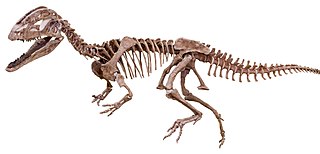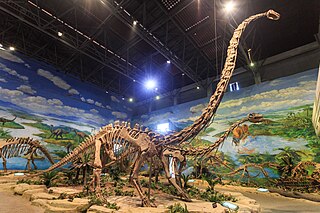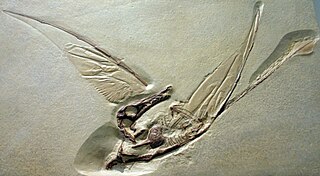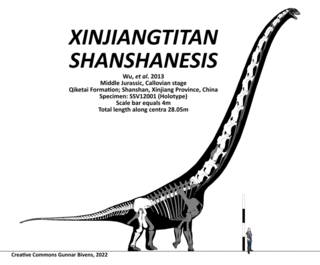
The Jurassic is a geologic period and stratigraphic system that spanned from the end of the Triassic Period 201.4 million years ago (Mya) to the beginning of the Cretaceous Period, approximately 145 Mya. The Jurassic constitutes the middle period of the Mesozoic Era and is named after the Jura Mountains, where limestone strata from the period were first identified.

Jurassic Park is a 1993 American science fiction action film directed by Steven Spielberg, produced by Kathleen Kennedy and Gerald R. Molen, and starring Sam Neill, Laura Dern, Jeff Goldblum, and Richard Attenborough. It is the first installment in the Jurassic Park franchise, and the first film in the original Jurassic Park trilogy, and is based on Michael Crichton's 1990 novel of the same name, with a screenplay by Crichton and David Koepp. The film is set on the fictional island of Isla Nublar, off Central America's Pacific Coast near Costa Rica, where a wealthy businessman John Hammond (Attenborough), and a team of genetic scientists have created a wildlife park of de-extinct dinosaurs. When industrial sabotage leads to a catastrophic shutdown of the park's power facilities and security precautions, a small group of visitors, including Hammond's grandchildren, struggle to survive and escape the now perilous island.

The Trachypachidae are a family of beetles that generally resemble small ground beetles, but that are distinguished by the large coxae of their rearmost legs. There are only six known extant species in the family, with four species of Trachypachus found in northern Eurasia and northern North America, and two species of Systolosoma in Chile and Argentina. They were much more diverse in the past, with dozens of described species from the Mesozoic.

Jurassic World is a 2015 American science fiction action film directed by Colin Trevorrow, who co-wrote the screenplay with Rick Jaffa, Amanda Silver, and Derek Connolly from a story by Jaffa and Silver. It is the first installment in the Jurassic World trilogy and the fourth installment overall in the Jurassic Park film series, following Jurassic Park III (2001). The film stars Chris Pratt, Bryce Dallas Howard, Vincent D'Onofrio, Ty Simpkins, Nick Robinson, Omar Sy, BD Wong, and Irrfan Khan. Wong reprised his role from the original Jurassic Park film. Set 22 years after the events of Jurassic Park, Jurassic World takes place on the same fictional island of Isla Nublar, located off the Pacific coast of Costa Rica. A successful theme park of cloned dinosaurs, dubbed Jurassic World, has operated on the island for years, bringing John Hammond's dream to fruition. The park plunges into chaos when a transgenic dinosaur escapes from its enclosure and goes on a rampage, while a conspiracy orchestrated by the park's staff creates more dangers.

Castorocauda is an extinct, semi-aquatic, superficially otter-like genus of docodont mammaliaforms with one species, C. lutrasimilis. It is part of the Yanliao Biota, found in the Daohugou Beds of Inner Mongolia, China dating to the Middle to Late Jurassic. It was part of an explosive Middle Jurassic radiation of Mammaliaformes moving into diverse habitats and niches. Its discovery in 2006, along with the discovery of other unusual mammaliaforms, disproves the previous hypothesis of Mammaliaformes remaining evolutionarily stagnant until the extinction of the non-avian dinosaurs.

Sinosaurus is an extinct genus of theropod dinosaur which lived during the Early Jurassic Period. It was a bipedal carnivore approximately 5.5 metres (18 ft) in length and 300 kilograms (660 lb) in body mass. Fossils of the animal were found at the Lufeng Formation, in the Yunnan Province of China.

Jurodidae is a family of beetles that was originally described for the extinct genus Jurodes, known from the Middle-Late Jurassic of Asia. In 1996, a living species, Sikhotealinia zhiltzovae was discovered in the Sikhote-Alin mountains in southeastern Siberia, and assigned to this family. Their placement is uncertain, but are usually considered archostematans. In one study, Sikhotealinia and Jurodes were considered a sister group to all other archostematan beetles. However, other authors have considered their placement within beetles as a whole uncertain, due to their mix characteristics of typical Archostemata, as well as Polyphaga and Adephaga.
Dashanpusaurus is an extinct genus of sauropod dinosaur that lived during the middle of the Jurassic period. The dinosaur was described in 2005 by Peng Guangzhao, Ye Yong, Gao Yuhui, Shu Chunkang, and Jiang Shan. Its type and only species is Dashanpusaurus dongi, named in honor of the paleontologist Dong Zhiming.
Sinemys is an extinct genus of turtle from the Late Jurassic to Early Cretaceous of China. Three species have been named: S. lens, the type species, from the Kimmeridgian-Tithonian of Shandong; S. gamera, from the Valanginian-Albian of Nei Mongol, and S. brevispinus from Early Cretaceous of Nei Mongol. S. wuerhoensis, from the Aptian-Albian of Xinjiang, is not referrable to this genus. Indeterminate specimen that may be belong to this genus is also known from Japan. The species S. gamera is noted for the presence of a pair of elongate spines projecting outwards and backwards from seventh costal of the carapace. These may have served a hydrodynamic function.

Pseudotribos is an extinct genus of mammaliaform that lived in Northern China during the Middle Jurassic some 165 million years ago, possibly more closely related to monotremes than to theria, although other studies indicate that these shuotheres are closer to therians than to monotremes. The only known specimen was found in the Daohugou Bed in Inner Mongolia.

Sinaspideretes is an extinct genus of turtle from the Late Jurassic of China, probably from the Shaximiao Formation. It is considered the earliest and most basal representative of the Trionychia, and is possibly the oldest known member of Cryptodira. In 2013, it was proposed that this animal and the genus Yehguia are in fact one and the same.
Shuotherium is a fossil mammaliaform known from Middle-Late Jurassic of the Forest Marble Formation of England, and the Shaximiao Formation of Sichuan, China.

Mamenchisauridae is a family of sauropod dinosaurs belonging to Eusauropoda known from the Jurassic and Early Cretaceous of Asia and Africa. Some members of the group reached gigantic sizes, amongst the largest of all sauropods.

The Tiaojishan Formation is a geological formation in Hebei and Liaoning, People's Republic of China, dating to the middle-late Jurassic period. It is known for its exceptionally preserved fossils, including those of plants, insects and vertebrates. It is made up mainly of pyroclastic rock interspersed with basic volcanic and sedimentary rocks. Previously, the Tiaojishan Formation was grouped together with the underlying Haifanggou Formation as a single "Lanqi Formation." The Tiaojishan Formation forms a key part of the Yanliao Biota assemblage, alongside the Haifanggou Formation.

Rhamphorhynchidae is a group of early pterosaurs named after Rhamphorhynchus, that lived in the Late Jurassic. The family Rhamphorhynchidae was named in 1870 by Harry Govier Seeley. Members of the group possess no more than 11 pairs of teeth in the rostrum, a deltopectoral crest that is constricted at the base but expanded at the distal end, and a bent phalange on the fifth toe.
Archaeoistiodactylus is an extinct genus of wukongopterid pterosaur from the Middle Jurassic of China.

Eosinopteryx is an extinct genus of theropod dinosaurs known to the Late Jurassic epoch of China. It contains a single species, Eosinopteryx brevipenna.
Aorun is a genus of carnivorous theropod dinosaur first discovered in 2006, with its scientific description published in 2013. It is possibly one of the oldest known coelurosaurian dinosaurs and is estimated to have lived ~161.6 million years ago during the Late Jurassic Period.

Xinjiangtitan is an extinct genus of mamenchisaurid sauropod that lived during the Middle Jurassic of what is now Xinjiang, northwestern China. Its type and only species is Xinjiangtitan shanshanesis, known from a single incomplete skeleton recovered from the Qiketai Formation. The holotype preserves one of the most complete vertebral columns of any sauropod found in Asia, and has the longest complete neck known for any animal.

Xinjiangchelys is an extinct genus of xinjiangchelyid turtle known from the Middle Jurassic to Early Cretaceous of China and Kyrgyzstan. It is known from over 11 different species.




















